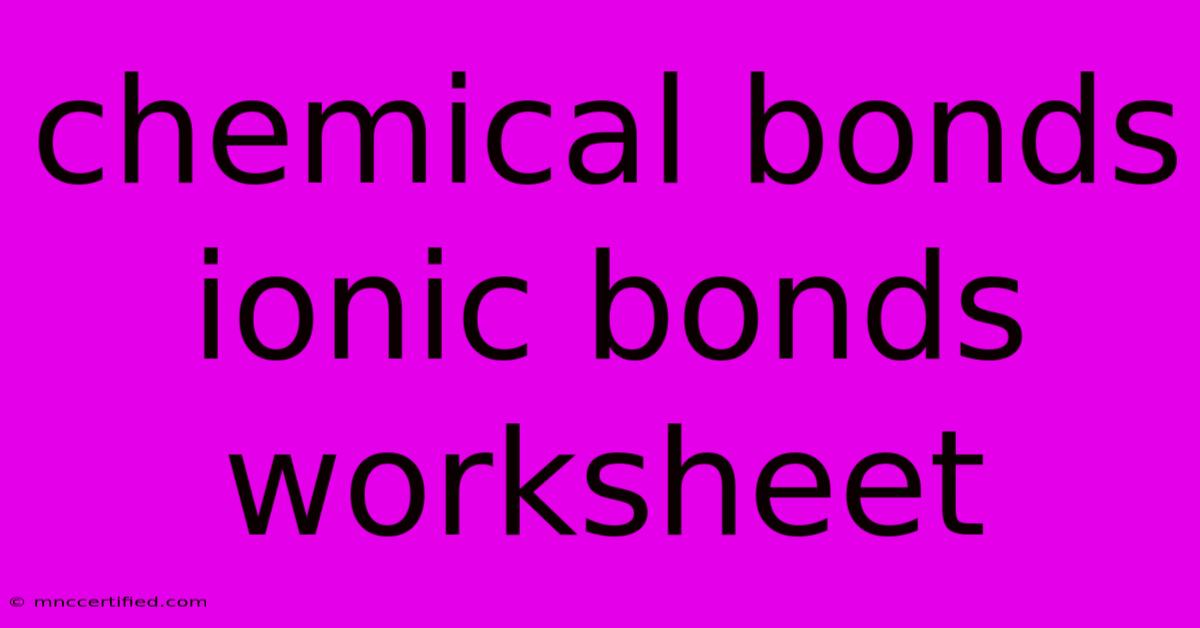Chemical Bonds Ionic Bonds Worksheet

Table of Contents
Demystifying Chemical Bonds: A Comprehensive Guide to Ionic Bonds with a Worksheet
Understanding chemical bonds is fundamental to comprehending the behavior of matter. Among the various types, ionic bonds stand out for their unique formation and properties. This article will provide a thorough exploration of ionic bonds, including their characteristics, formation, and applications. To reinforce your understanding, we'll conclude with a worksheet designed to help you solidify your knowledge.
What are Ionic Bonds?
Ionic bonds are a type of chemical bond formed through the electrostatic attraction between oppositely charged ions. This attraction arises from the transfer of electrons from one atom to another. The atom that loses electrons becomes a positively charged cation, while the atom that gains electrons becomes a negatively charged anion.
Key Characteristics of Ionic Bonds:
- High melting and boiling points: The strong electrostatic forces require significant energy to overcome, leading to high melting and boiling points.
- Good conductors of electricity in the molten state or when dissolved in water: The free movement of ions allows for the conduction of electricity.
- Brittle: The rigid lattice structure of ionic compounds makes them susceptible to breakage under stress.
- Usually form between metals and nonmetals: Metals tend to lose electrons (forming cations), while nonmetals tend to gain electrons (forming anions).
Formation of Ionic Bonds: A Step-by-Step Process
- Electron Transfer: A metal atom loses one or more electrons to become a positively charged cation. A nonmetal atom gains one or more electrons to become a negatively charged anion.
- Electrostatic Attraction: The oppositely charged ions attract each other due to electrostatic forces.
- Ionic Lattice Formation: The ions arrange themselves in a repeating, three-dimensional structure called an ionic lattice.
Examples of Ionic Compounds
Here are some common examples of ionic compounds:
- Sodium chloride (NaCl): Sodium (Na) loses an electron to become Na+, while chlorine (Cl) gains an electron to become Cl-. The attraction between Na+ and Cl- forms the ionic compound NaCl.
- Magnesium oxide (MgO): Magnesium (Mg) loses two electrons to become Mg2+, while oxygen (O) gains two electrons to become O2-. The attraction between Mg2+ and O2- forms the ionic compound MgO.
- Calcium chloride (CaCl2): Calcium (Ca) loses two electrons to become Ca2+, while two chlorine atoms each gain one electron to become 2Cl-. The attraction between Ca2+ and 2Cl- forms the ionic compound CaCl2.
The Importance of Ionic Bonds
Ionic bonds play a crucial role in various areas, including:
- Biology: Ionic bonds are essential in maintaining the structure of biological molecules like proteins and DNA.
- Chemistry: They are fundamental to understanding chemical reactions and the properties of matter.
- Medicine: Ionic compounds are used in various medications and therapies, including electrolytes for hydration and treatment of mineral deficiencies.
Worksheet: Test Your Understanding of Ionic Bonds
Now, it's time to solidify your understanding of ionic bonds with a worksheet.
Instructions:
- Identify the cation and anion: Given the chemical formula of an ionic compound, identify the cation and anion present.
- Write the ionic formula: Given the elements involved, write the correct ionic formula for the compound formed.
- Describe the formation of the ionic bond: Briefly explain the electron transfer process that leads to the formation of the ionic bond.
Questions:
- Identify the cation and anion in the following ionic compounds:
- KCl
- CaO
- Al2O3
- Write the ionic formula for the compounds formed between the following elements:
- Lithium (Li) and Fluorine (F)
- Magnesium (Mg) and Oxygen (O)
- Aluminum (Al) and Chlorine (Cl)
- Describe the formation of the ionic bond in NaCl.
Answers:
- KCl: K+ (cation), Cl- (anion) CaO: Ca2+ (cation), O2- (anion) Al2O3: Al3+ (cation), O2- (anion)
- Lithium (Li) and Fluorine (F): LiF Magnesium (Mg) and Oxygen (O): MgO Aluminum (Al) and Chlorine (Cl): AlCl3
- In NaCl, sodium (Na) loses one electron to become Na+, while chlorine (Cl) gains one electron to become Cl-. The attraction between Na+ and Cl- forms the ionic compound NaCl.
By completing this worksheet, you will gain a deeper understanding of ionic bonds and their significance in chemistry and beyond. Remember that understanding these fundamental concepts is crucial for success in further scientific pursuits.

Thank you for visiting our website wich cover about Chemical Bonds Ionic Bonds Worksheet. We hope the information provided has been useful to you. Feel free to contact us if you have any questions or need further assistance. See you next time and dont miss to bookmark.
Featured Posts
-
Watch Commanders Vs Steelers Tv Radio Online
Nov 11, 2024
-
Barcelona Vs Real Sociedad Game Recap
Nov 11, 2024
-
Harley Davidson Motorcycle Insurance
Nov 11, 2024
-
Wednesday Fan Mocks Former Sheffield United Players Death
Nov 11, 2024
-
Mohammad Rizwan Makes History In Australia
Nov 11, 2024